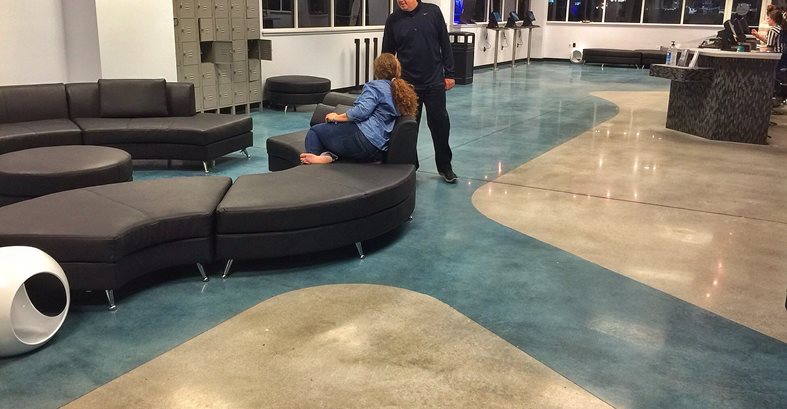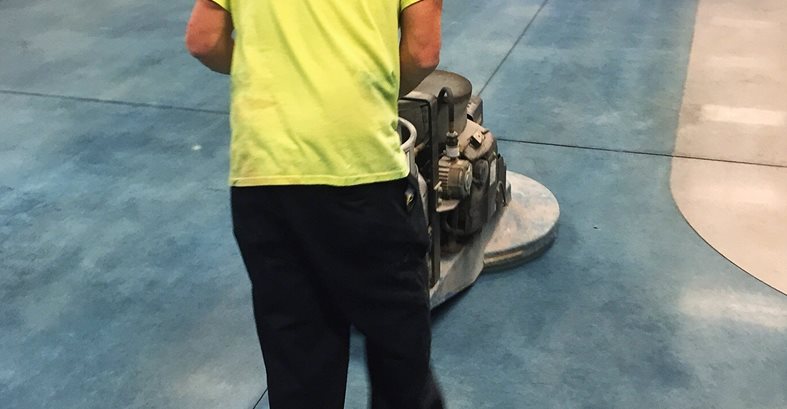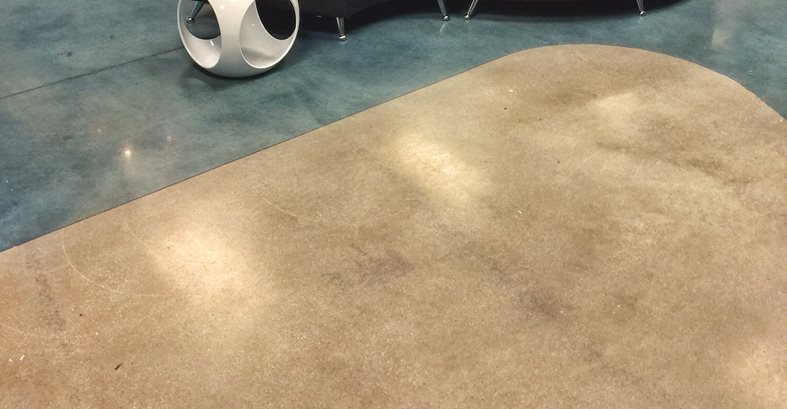- Polished Concrete Information
- Polished Concrete Pictures
- What is Polished Concrete
- Polished Concrete Cost
- Design Ideas for Polished Concrete
- Polished Concrete Maintenance
- Common Questions about Polished Concrete
- Can All Concrete be Polished?
- Comparison Chart: Polished concrete versus other flooring materials
- What are Polished Overlays?
- Polishing Products and Equipment: An overview of basic equipment and supplies needed
- Related Information
- Information About: Concrete Floors
- Concrete Contractors: Find Concrete Polishing Products and Suppliers
- Design Ideas: Polished Concrete Info
Jumping for Joy Over Polished Concrete
Project submitted by Matt Hine, Progressive Concrete Coatings, Wilmington, N.C.The newly dyed and polished concrete floor in the Defy Gravity Trampoline Park, Wilmington, N.C., has the owners of the facility walking on air, not only because the floor is so easy to maintain, but also because of its attractive pattern and color scheme.
"The owners of Defy Gravity wanted a floor that could withstand the high amount of foot traffic that their facility experiences. They also host birthday parties, increasing the potential for spilled food and drinks. They chose polished concrete over carpet for cleanability," says Matt Hine, president of Progressive Concrete.
As luck would have it, Progressive Concrete had performed acid staining and decorative sawcutting on this floor for the facility's previous owner. They were able to use the previous sawcut traffic pattern to define the new color scheme for Defy Gravity, which is a combination of patriot blue and natural concrete.
Hine's crew started off by grinding the 4,400-square-foot floor with 30-grit metal tooling to cut through the original sealer and stain. Residual carpet glue was also removed in certain areas. Next, they went over the floor with both 50 and 100 grit metal tooling. The floor was then densified before moving on to the resin pad passes.
"Dye was applied after the 200 grit resins, then we continued with 400 grit and finished up with 800 grit resins,” says Hine. “The floor was then sealed with two coats of penetrating sealer and finally burnished with a propane buffer. We went with a penetrating sealer in place of a topical sealer to achieve stain resistance without sacrificing the natural look of the polished concrete.”
The demand for polished concrete over traditional acid stained floors is growing, says Hine, especially because of its low maintenance needs. "When floors that are acid stained and sealed with acrylic sealers are allowed to wear through, the stain itself will wear off as well. We have switched to offering dyed and polished concrete to prevent these issues."
Hine has also seen an increase in the demand for residential polished concrete because of its durability. "In our coastal area, polished concrete holds up well to the high amount of sand that gets tracked into beach homes. It's also a great choice for homes that have a potential for coastal flooding, where other flooring would need to be replaced in the event of a hurricane or major storm," he says.
Equipment and materials used:
Concrete grinder: Stonekor LX-30 propane grinder and polisher
Floor buffer: Eagle 27-inch propane buffer
Concrete dye: Ameripolish SureLock Dye, in patriot blue
Polishing contractor
Matt Hine
Progressive Concrete Coatings, Wilmington, N.C.
Get more polished concrete design ideas
See more examples of commercial concrete flooring







